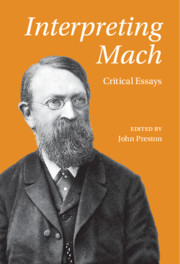Book contents
- Interpreting Mach
- Interpreting Mach
- Copyright page
- Dedication
- Contents
- Figures
- Tables
- Contributors
- Introduction
- 1 Ernst Mach’s Piano and the Making of a Psychophysical Imaginarium
- 2 Mother’s Milk and More
- 3 Meaningful Work
- 4 Mach on Analogy in Science
- 5 Ernst Mach’s Enlightenment Pragmatism
- 6 On the Philosophical and Scientific Relationship between Ernst Mach and William James
- 7 Ernst Mach and Friedrich Nietzsche
- 8 Abstraction, Pragmatism, and History in Mach’s Economy of Science
- 9 Holding the Hand of History
- 10 Ernst Mach and the Vienna Circle
- 11 Narratives Divided
- 12 Phenomenalism, or Neutral Monism, in Mach’s Analysis of Sensations?
- 13 The Case for Mach’s Neutral Monism
- Index
- References
2 - Mother’s Milk and More
On the Role of Ernst Mach’s Relational Physics in the Development of Einstein’s Theory of Relativity
Published online by Cambridge University Press: 05 March 2021
- Interpreting Mach
- Interpreting Mach
- Copyright page
- Dedication
- Contents
- Figures
- Tables
- Contributors
- Introduction
- 1 Ernst Mach’s Piano and the Making of a Psychophysical Imaginarium
- 2 Mother’s Milk and More
- 3 Meaningful Work
- 4 Mach on Analogy in Science
- 5 Ernst Mach’s Enlightenment Pragmatism
- 6 On the Philosophical and Scientific Relationship between Ernst Mach and William James
- 7 Ernst Mach and Friedrich Nietzsche
- 8 Abstraction, Pragmatism, and History in Mach’s Economy of Science
- 9 Holding the Hand of History
- 10 Ernst Mach and the Vienna Circle
- 11 Narratives Divided
- 12 Phenomenalism, or Neutral Monism, in Mach’s Analysis of Sensations?
- 13 The Case for Mach’s Neutral Monism
- Index
- References
Summary
This chapter examines the changing relations between Mach’s epistemology and his mechanics to offer a new perspective on the diverse respects in which Einstein built on Mach’s work. Considering Mach’s early psychophysical research on sensations of space and time indicates foundations both for Mach’s later research on physical space and time and for his search for an epistemology capable of encompassing conceptions and perceptual experience, but also psychology, physics, and psychophysics, as well as the social world: all knowledge. I show that Mach’s critical studies of mass and inertia emerged from his perceptual studies and were intimately linked to bodily experience and experiment. Considering his well-known Mechanics indicates that Mach sought to train the imagination as well as stimulate critique in the attacks on absolutes that are now usually taken to define his anti-metaphysical empiricism. I argue that while celebrating the role of Mach’s criticism, Einstein remained unaware of the extent to which his initial approach to general relativity was shaped by a pedagogical thought experiment on action and reaction in which Mach linked gravitation and acceleration. Finally, when he turned explicitly to epistemology, rather than emphasising positivist empiricism, Mach offered a study of the psychology of research in practice.
- Type
- Chapter
- Information
- Interpreting MachCritical Essays, pp. 28 - 47Publisher: Cambridge University PressPrint publication year: 2021



